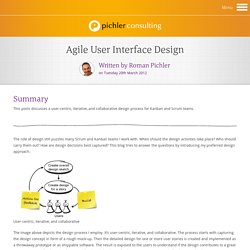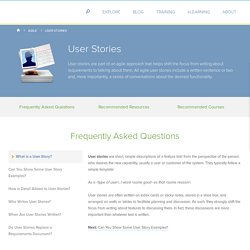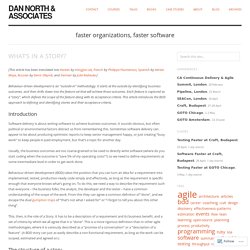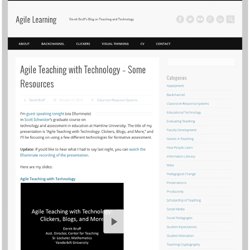

Accueil - Agile Québec. 10 Tips for Writing Good User Stories. 1.

Focus on the user As its name suggests, a user story tells a story about a customer or user employing the product. Write therefore stories from the user’s perspective and show how a user or customer uses some product functionality. 2. Write stories collaboratively A user story is not a specification, but an communication and collaboration tool. 3. Write your stories so that they are easy to understand. Agile User Interface Design. The role of design still puzzles many Scrum and Kanban teams I work with.

When should the design activities take place? Who should carry them out? How are design decisions best captured? This blog tries to answer the questions by introducing my preferred design approach. User-centric, iterative, and collaborative The image above depicts the design process I employ. High-level Design To get started, develop your design concept. For instance, the high-level design below shows how the structure, shapes and colours of our new homepage together with a photo of a bald guy with a beard and sticky notes. High-level website design. User Stories. User stories are short, simple descriptions of a feature told from the perspective of the person who desires the new capability, usually a user or customer of the system.

They typically follow a simple template: As a <type of user>, I want <some goal> so that <some reason>. User stories are often written on index cards or sticky notes, stored in a shoe box, and arranged on walls or tables to facilitate planning and discussion. As such, they strongly shift the focus from writing about features to discussing them. In fact, these discussions are more important than whatever text is written.
The Easy Way to Writing Good User Stories. Many development shops have opted to writing user stories over traditional feature/requirement documents; however, almost all of them struggle when writing their first batch of user stories.

What’s in a Story? [This article has been translated into Korean by HongJoo Lee, French by Philippe Poumaroux, Spanish by Adrian Moya, Russian by Denis Oleynik, and German by Julia Kadauke.]

Behaviour-driven development is an “outside-in” methodology. It starts at the outside by identifying business outcomes, and then drills down into the feature set that will achieve those outcomes. Each feature is captured as a “story”, which defines the scope of the feature along with its acceptance criteria. This article introduces the BDD approach to defining and identifying stories and their acceptance criteria. Introduction Software delivery is about writing software to achieve business outcomes. Usually, the business outcomes are too coarse-grained to be used to directly write software (where do you start coding when the outcome is “save 5% of my operating costs”?)
Agile Schools: How Technology Saves Education (Just Not the Way We Thought it Would) Education in America is stuck.

No Child Left Behind, the landmark federal legislation passed under the Bush administration in 2001, ushered in an unprecedented era of curriculum standards, high-stakes testing, and consequential accountability. But this historic bill long ago began to show its age. Scheduled for reauthorization in 2007, and in serious need of a tune-up, the highly controversial law has languished while the Obama administration has wrestled with the economic crisis, healthcare reform, and other pressing concerns. As a result, NCLB is unlikely to be addressed until after the 2012 election.
Unfortunately, the incredible degree of bipartisan support that marked its original passage (Ted Kennedy was the democratic co-sponsor) no longer exists, and chances for significant and positive improvement are slim. In the meantime, growth in student achievement, modest though it has been during the NCLB years, has slowed. Agile Teaching. Agile Teaching with Technology – Some Resources. I’m guest speaking tonight (via Elluminate) in Scott Schwister ‘s graduate course on technology and assessment in education at Hamline University.

The title of my presentation is “Agile Teaching with Technology: Clickers, Blogs, and More,” and I’ll be focusing on using a few different technologies for formative assessment. Update: If you’d like to hear what I had to say last night, you can watch the Elluminate recording of the presentation . Here are my slides: Below you’ll find some related resources. Clickers My book on clickers is titled Teaching with Classroom Response Systems , and I blog regularly about teaching with clickers .
Backchannel I also blog fairly regularly on using backchannel tools in the classroom . Blogs I wrote about my approach to using WordPress blogs to facilitate pre-class reading assignments over on ProfHacker . Image: “nose slide” by Flickr user B.A.D., Creative Commons licensed. Journeys of a young Software Engineer. I’ve been at the XP 2012 conference and I had a great time and a lot of interesting conversations.

One topic that particularly intrigued me is how we can teach agile software development at universities. There are, to my knowledge, quite some universities that don’t teach agile software development at all or do it very badly. I attended a good talk by Mark Lainez. He, and some of his colleagues, use their spare time in order to give presentations and hold workshops about agile at Belgian universities. This is super awesome. This post is mainly aimed at people like Mark and lecturers at universities, who want to introduce “Agile” to universities. Theory is good – but people need practice Let me tell you something about my studies at the Hasso Plattner Institute: We learn about design patterns in our third bachelor semester! It’s the same thing with teaching agile, people need to work on something real in order to realize the benefits.
At my university we had the Lego Scrum exercise. Agile.